Hip Revision
Introduction
The main goal for hip revision surgery is to repair an artificial hip implant which may not be securely attached to the bone, resulting in abnormal motion that causes pain. Hip revision surgery is an attempt to repair the hip and restore it to a condition where it can function normally.
Hip revision surgery is also known as revision total hip arthroplasty. In this procedure, the surgeon removes a previously implanted artificial hip joint (prosthesis), and replaces it with a new prosthesis. Hip revision surgery may also involve the use of bone grafts. The bone graft may be an autograft, which means that the bone is taken from another site in the patient’s own body. It may be an allograft, which means that the bone tissue comes from another donor.
Objective of the surgery
Hip revision surgery has three major purposes: relief of pain in the affected hip; restoring the mobility of the patient; and removing a loose or damaged prosthesis before irreversible damage occurs to the joint. Hip prostheses containing parts made of polyethylene typically become loose because of wear and tear on the prosthesis. The wear gradually produces tiny particles of plastic that irritate the soft tissue around the prosthesis. This inflamed tissue begins to dissolve the underlying bone and this process is known as osteolysis. Eventually, the soft tissue expands around the prosthesis to the point at which the prosthesis loses contact with the bone.
Iran ranks among the top 10 countries in orthopedics and Iranian surgeons perform high quality orthopedic surgeries at highly affordable prices

Preoperative preparation
Certain health conditions or co-morbidities are considered as contraindications for hip revision surgery. These include:
1. Existing hip infection
2. Dementia or other severe mental disorders
3. Severe vascular disease
4. Poor condition of the skin covering the hip joint
5. Extreme obesity
6. Quadriceps muscle paralysis
7. Terminal illness
Patients who are considered appropriate candidates for hip revision surgery are admitted to the hospital about a week before the operation. X rays and other diagnostic images of the hip are reviewed in order to select the new prosthesis. This review is called as templating as the diagnostic images of the old implant serve as a template for the new implant. The surgeon also decides whether any special procedures or instruments will be needed to remove the old prosthesis.
During the procedure
Patients who are considered appropriate candidates for hip revision surgery are admitted to the hospital about a week before the operation.
This surgery is usually done under regional anesthesia. During hip replacement surgery, the diseased portions of the hip are excised or cut away and replaced with an artificial hip joint. With hip revision surgery, the artificial hip joint is removed and replaced with a new one. Depending on the severity of the infection, more than one hip revision surgery may be required. In such more severe cases, the first surgery is needed to remove the old prosthesis scar tissue and also to treat the joint with antibiotics for the infection. When the hip is cured of infection, surgery is performed to provide a new prosthesis.
Post-surgery
After surgery, medicines or therapy is prescribed by the surgeon to prevent the formation of blood clots. To decrease the chances of having a Deep Vein Thrombosis (DVT) after surgery, various approaches are available such as medications, wearing special stockings and doing ankle pumps two to three days following surgery. A new approach known as patient-controlled analgesia (PCA) is given which allows the patient to control the dose of pain medication through an IV and lasts for one or two days after surgery. An appointment may be fixed after surgery depending on the wound closure method preferred by the surgeon to remove the sutures. The surgeon should be called quickly before this appointment if there are any of the following symptoms:
1. Increased redness
2. Pain or swelling
3. Drainage at the incision site
4. Bumps or pimples
Outcome of the surgery
In general, hip revision surgery has less favourable outcomes than first-time replacement surgery. The greater length and complexity of the procedure makes the patient to stay in hospital for a longer period as well as the recovery period at home is also prolonged. The range of motion in the new joint is usually limited than in the first prosthesis, and the patient may experience greater long-term discomfort. In addition, the new prosthesis does not last usually for long time. The life expectancy of implants used in first-time hip replacement surgery is usually expected to be about 10–15 years, whereas revision implants may need to be removed after eight to 10 years.